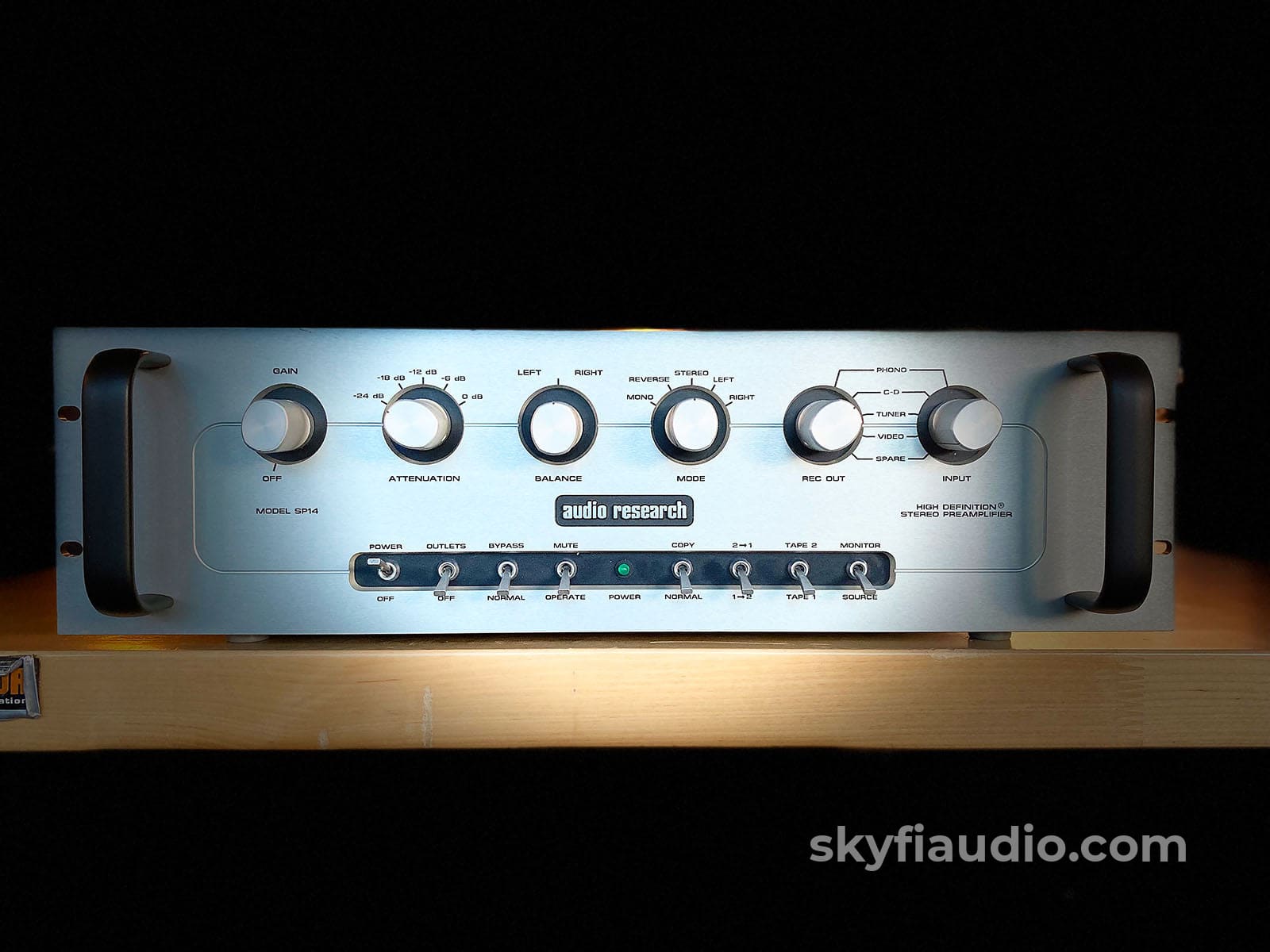
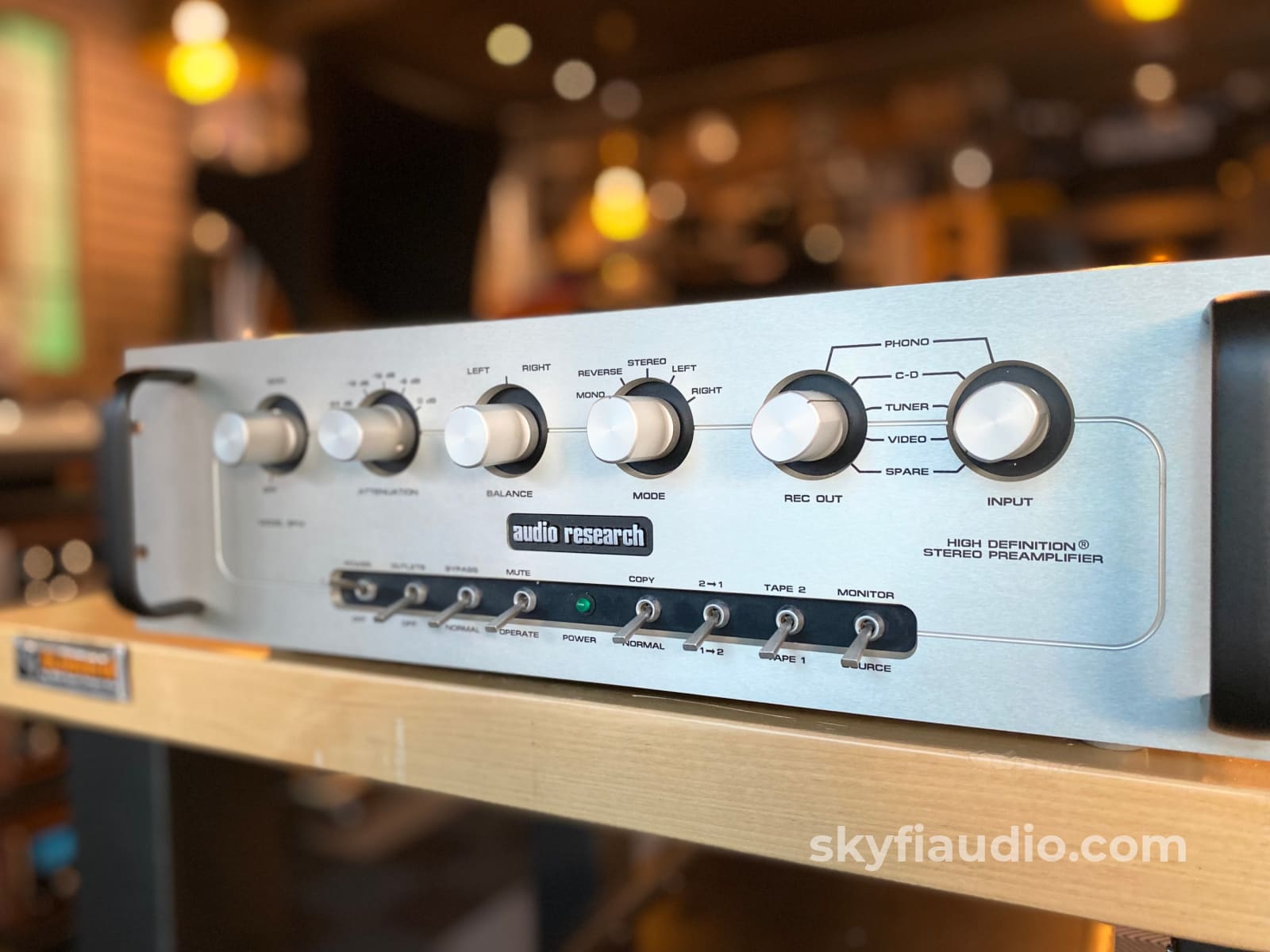
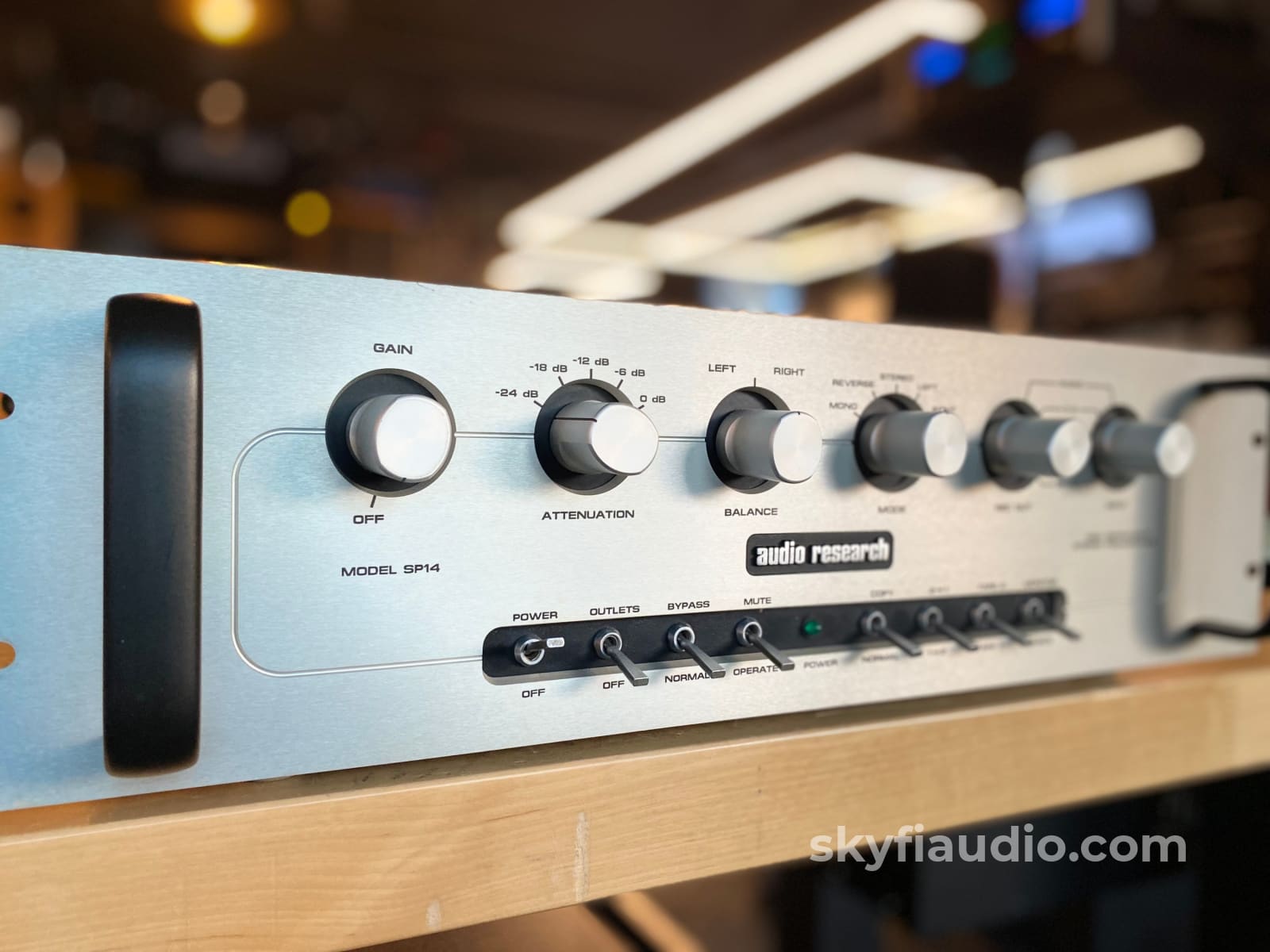
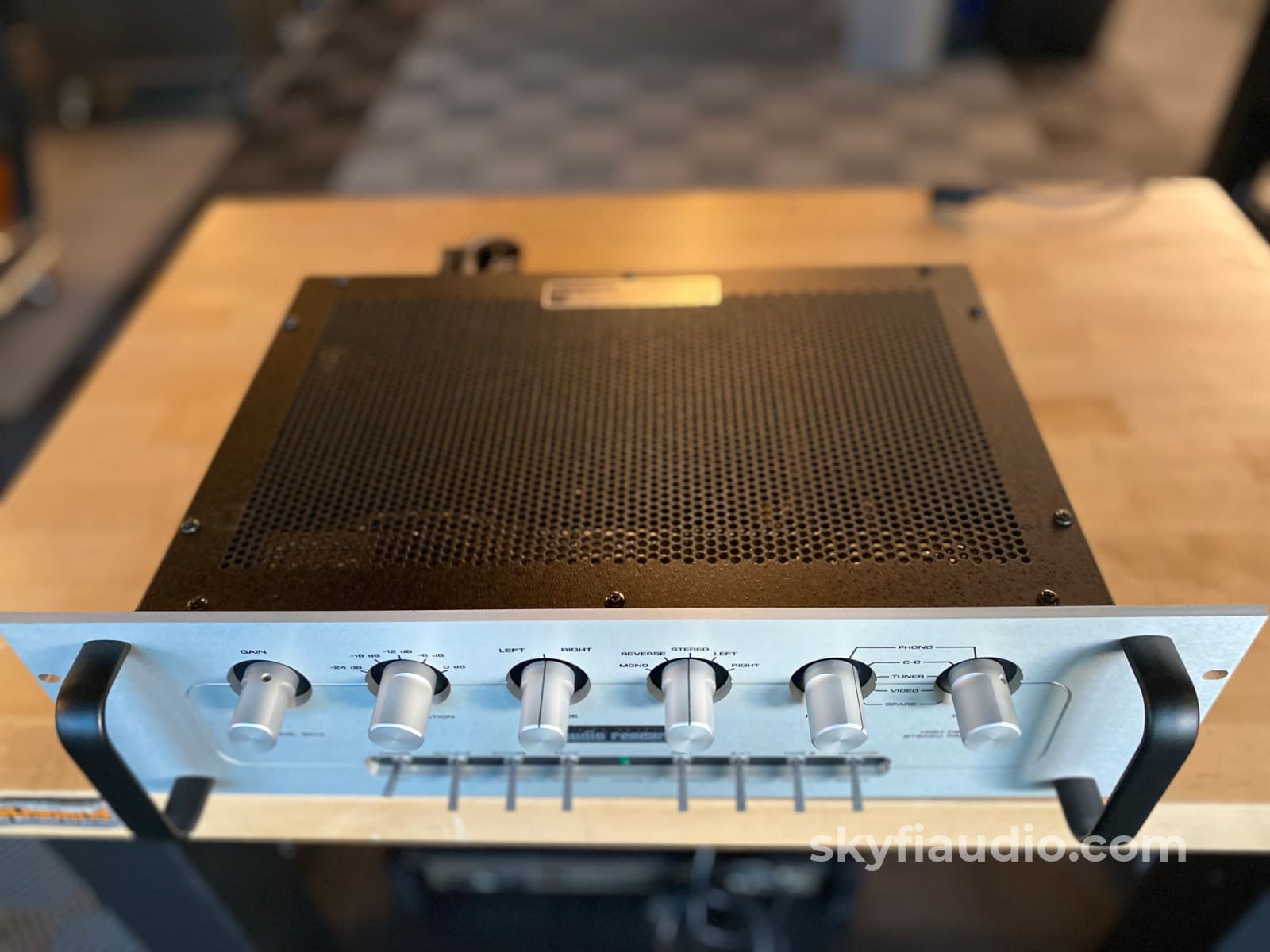
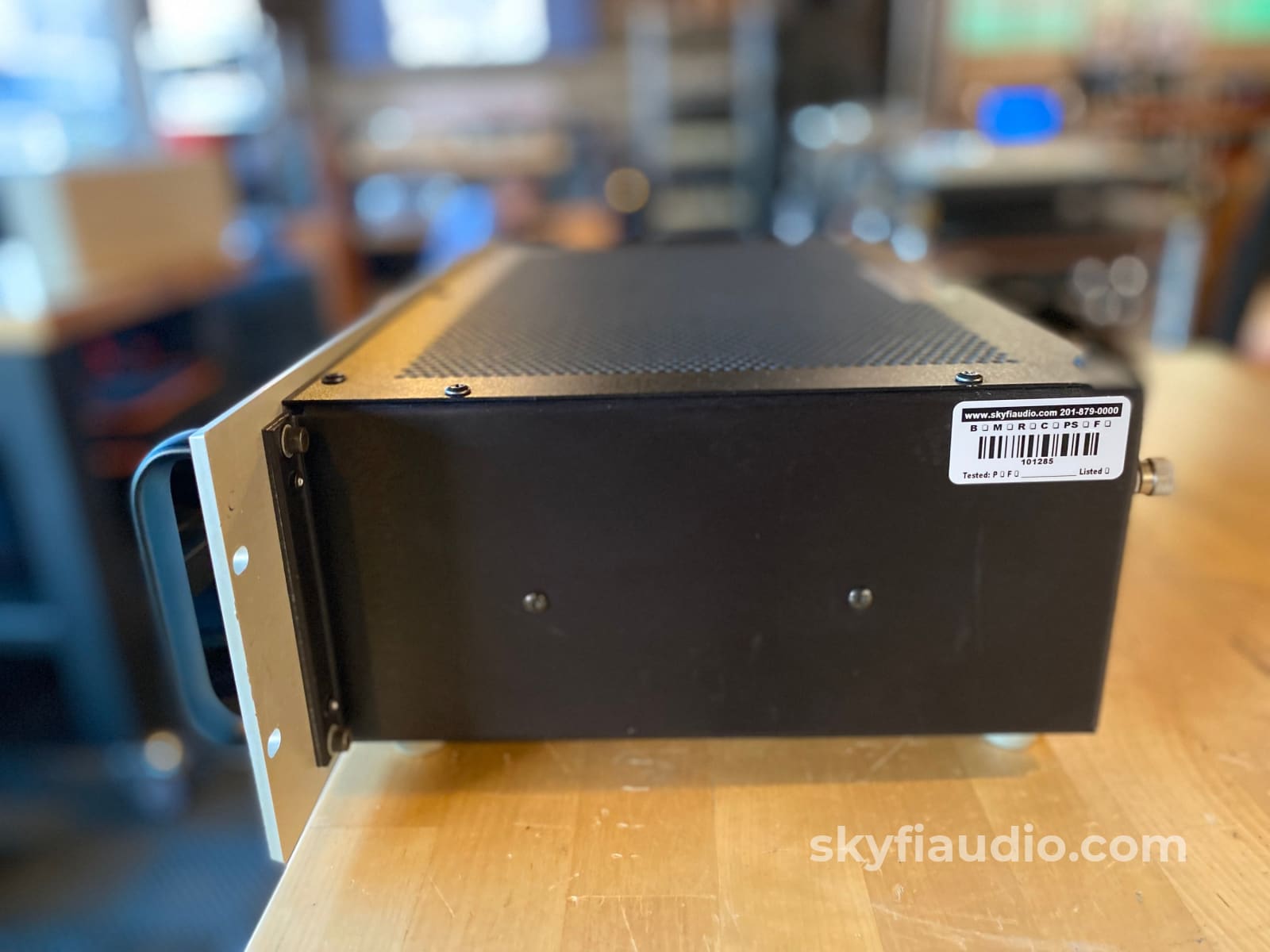
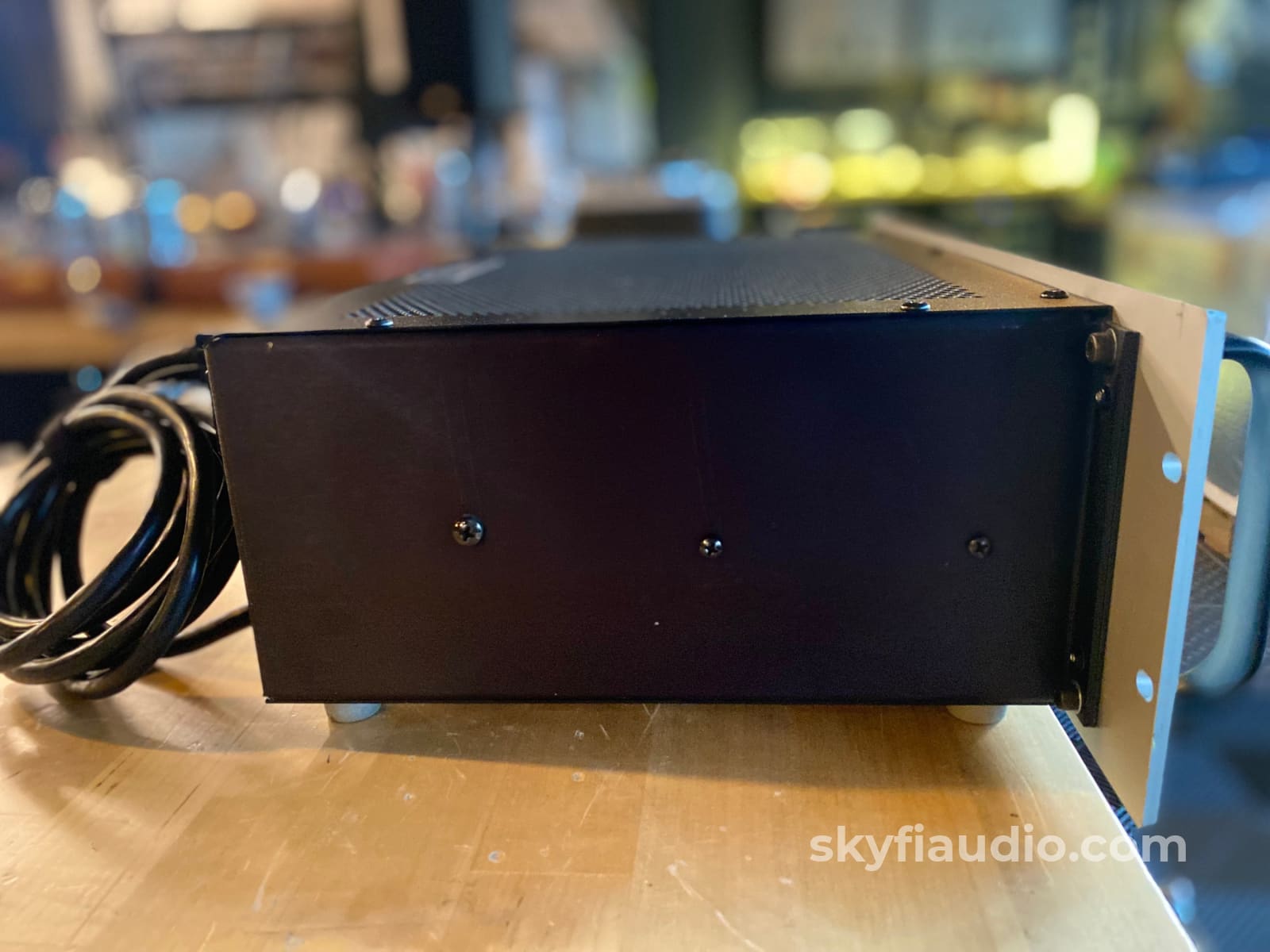
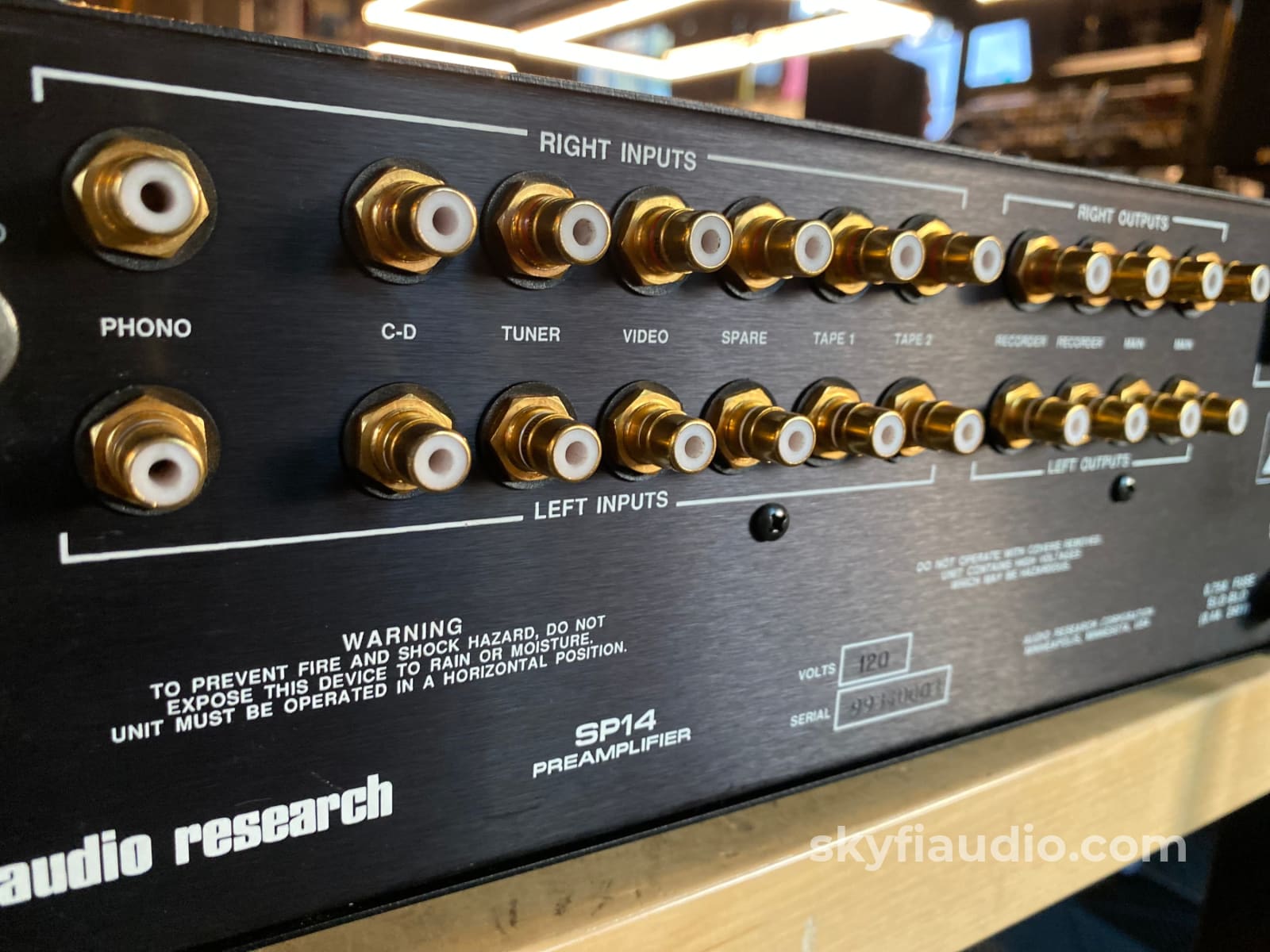
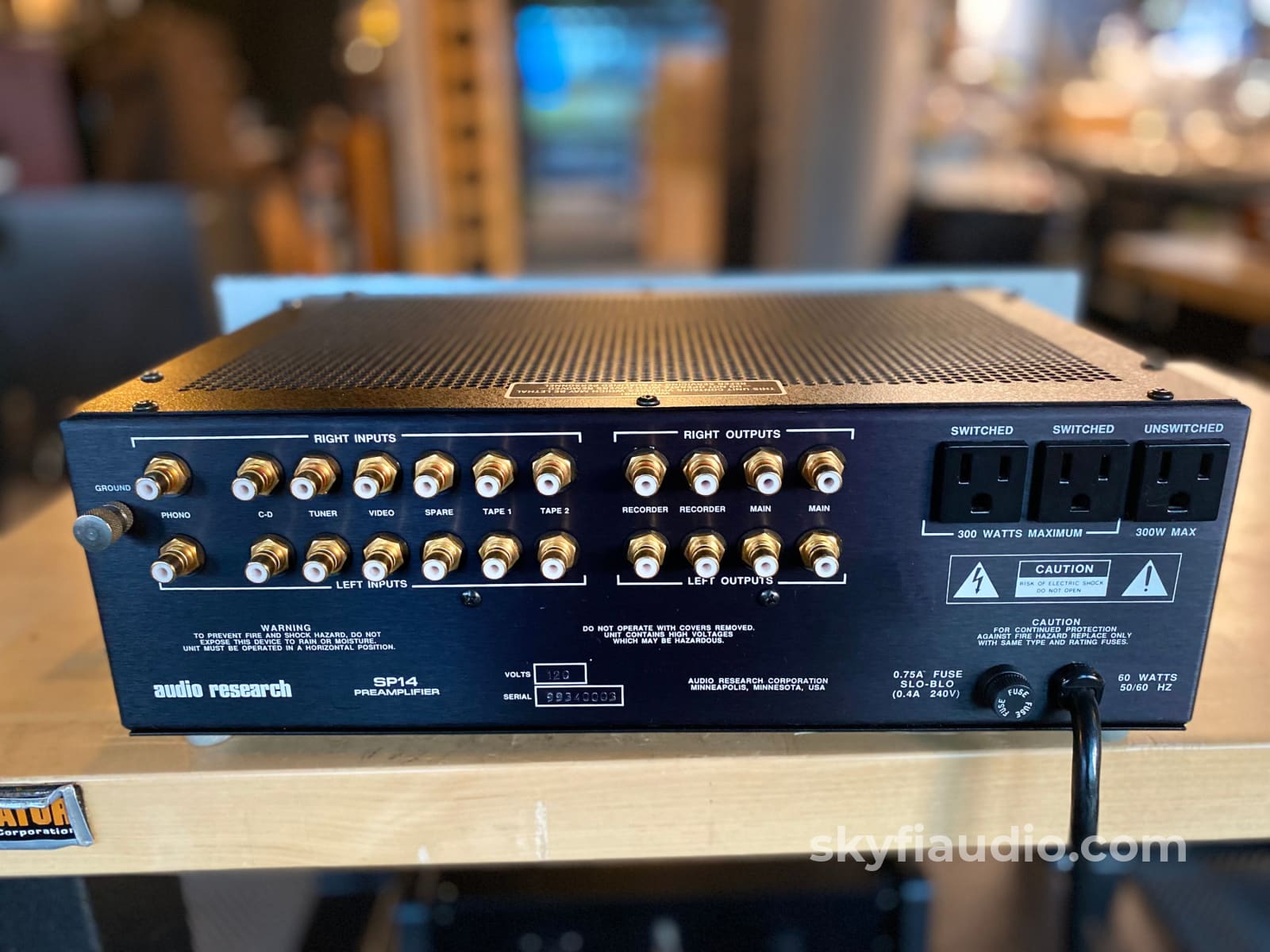
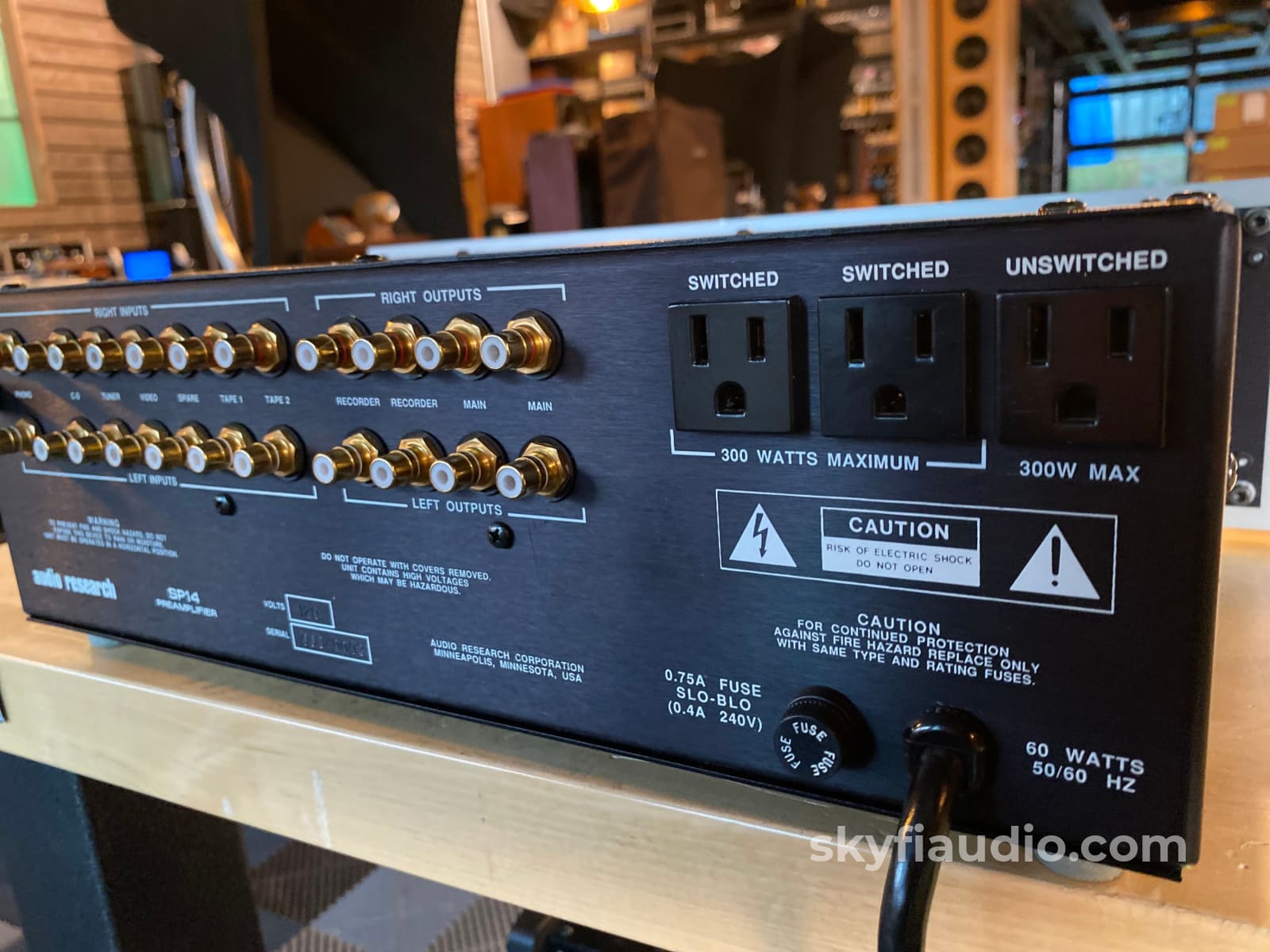
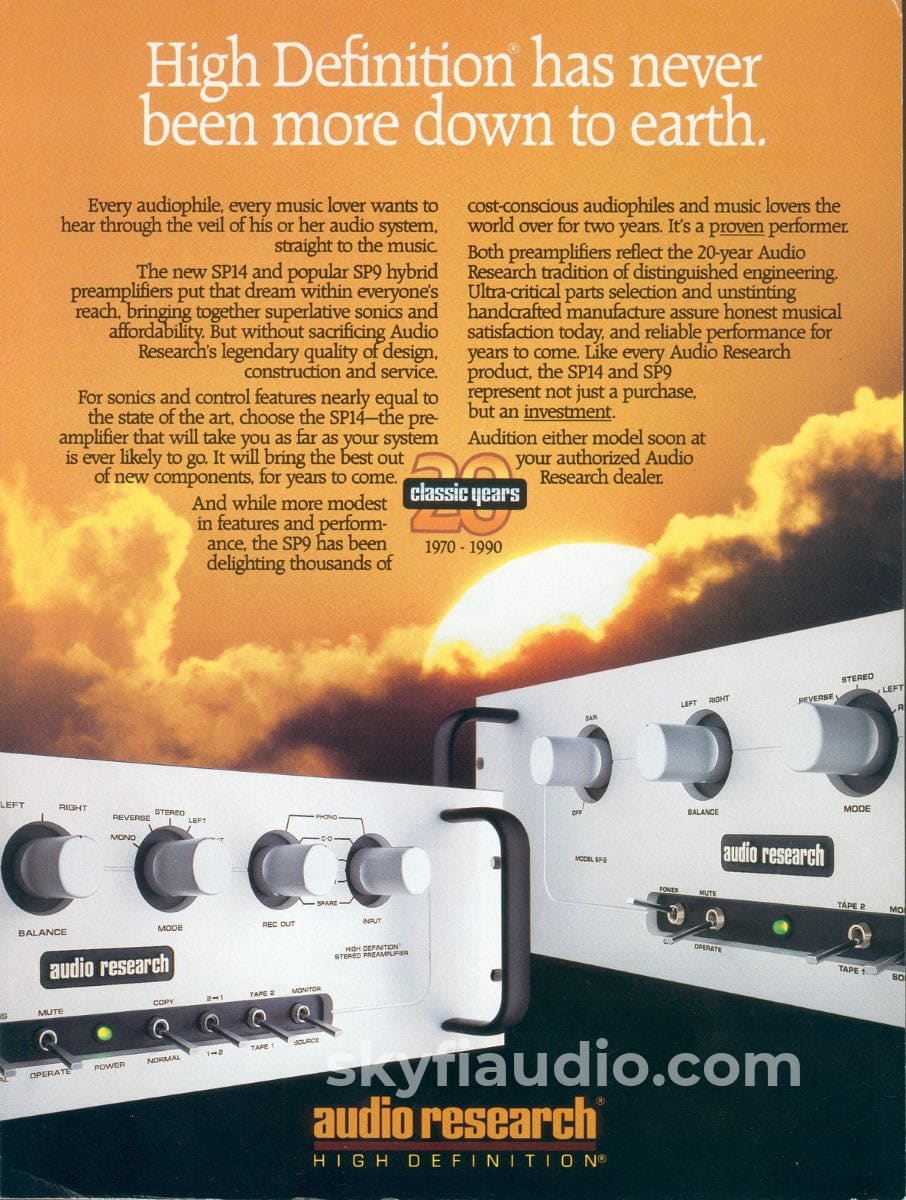
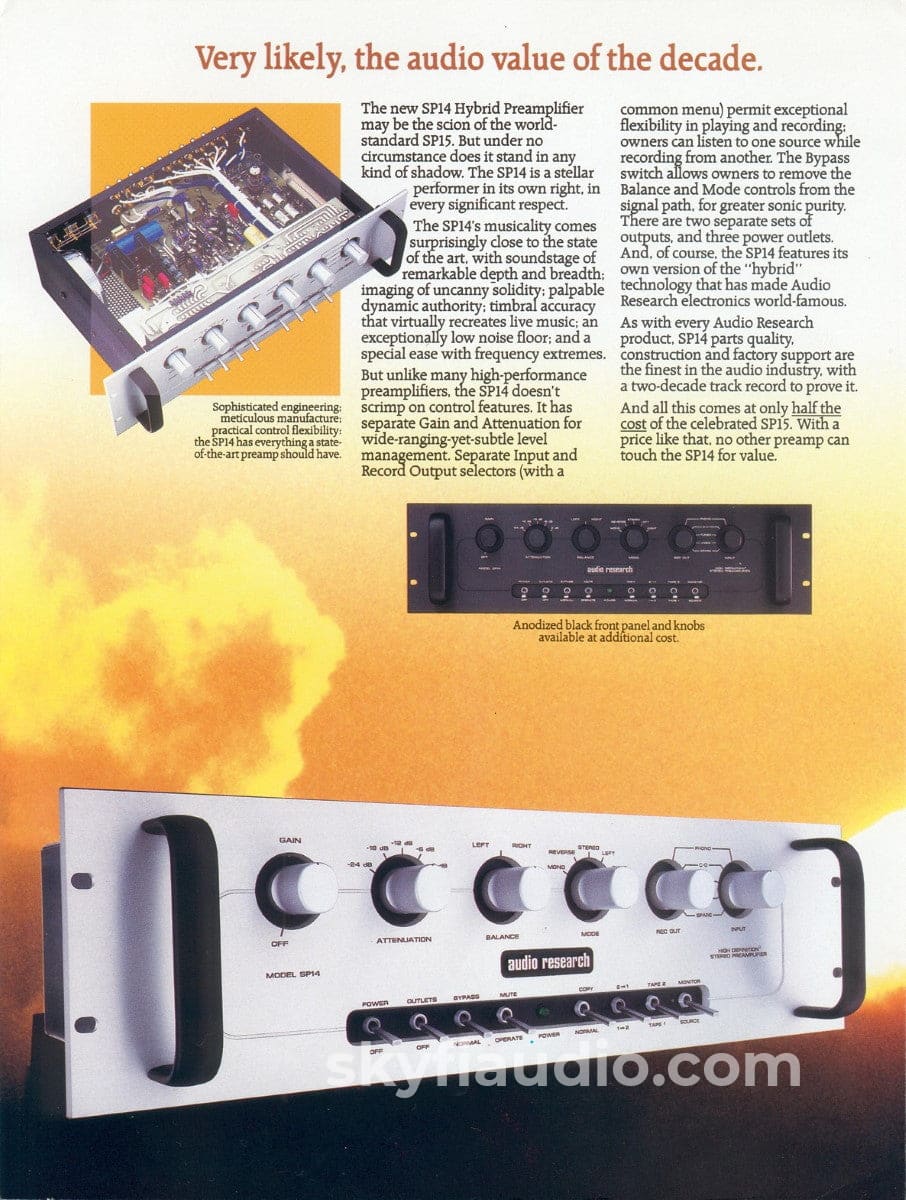
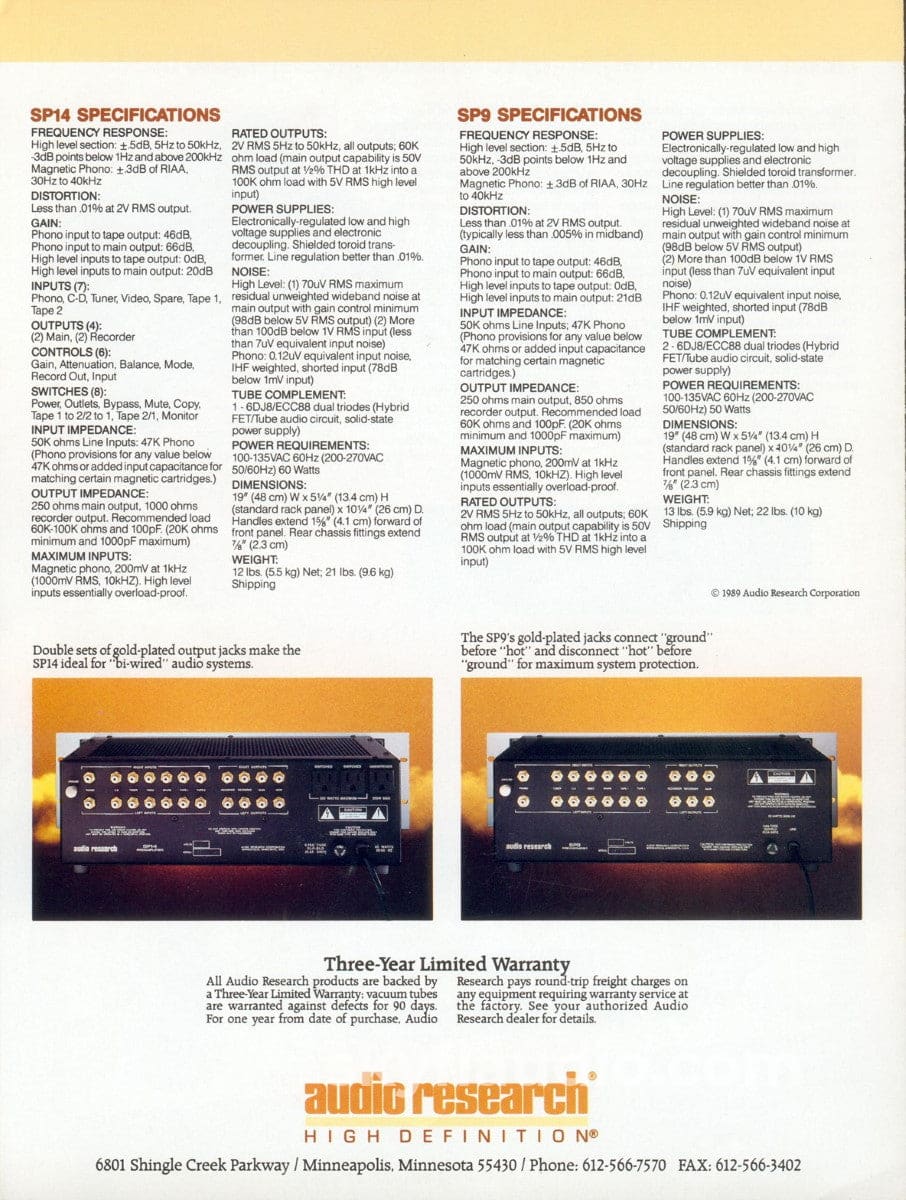
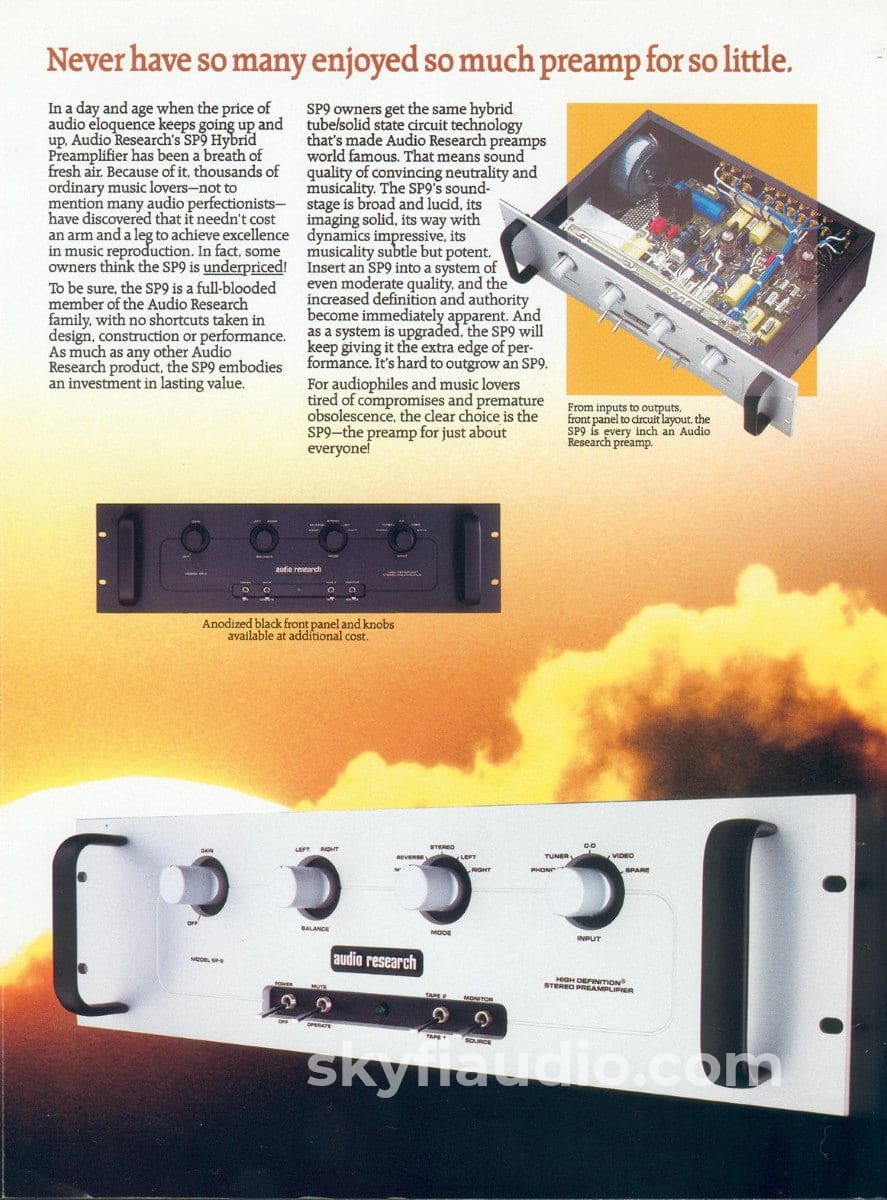
Audio Research SP14 Hybrid Vintage Preamplifier with Phono
Free Shipping on Most Electronics - Excludes Speakers and Items Requiring Freight - Contiguous U.S. Only
Pickup currently unavailable at SkyFi 479

Audio Research SP14 Hybrid Vintage Preamplifier with Phono
SkyFi 479
479 South Broad Street
Glen Rock NJ 07452
United States
General:
The SP14 is a hybrid design, and follows in the tradition of the SP9 MKII in using one 6DJ8 dual-triode vacuum tube in an intermediate gain stage of the phono section. The line section is all-FET, using a circuit similar to that in the SP15.
Unlike the LS units, the SP's have a built-in phono stage making them a better value.
This unit is built to the quality standard you'd expect from this renown American manufacturer.
Brand Background:
Audio Research continues its dedication to unparalleled musical expression and crafting components of the highest quality and lasting value for its customers. Our long-term dedication to service is peerless in this industry (Audio Research, with few exceptions, can repair anything ever produced during its entire history). We continue to seek out new and exciting ways to make music more real and more enjoyable. More than just a name or a marketing tool, Audio Research has come to represent exceptional performance and long-term value. Experience Audio Research – experience High Definition®.
Ownership:
One single owner since new and was well cared for.
Amplifier Recommendations:
Both solid state and tube should pair well with this unit. A good ARC match would be a REF160, 250SE, 150, or 75.
Connections:
7 Sets of inputs and 4 sets of outputs, all single ended. 15A removable power cord.
General Sound:
Warm tube sound with great harmonics and laid-back delivery. Super neutral and clean sounding with little to no sonic signature.
Cosmetic Condition:
We rated this a 7 with light signs of use and wear. See our detailed rating description here.
Working Condition and Technical Notes:
Working properly, fully tested in our lab and listening room.
Phono Notes:
• The phono stage in this unit is currently setup in the default factory configuration of 47K load impedance and 600pF capacitance. This is suitable for most MM (Moving-Magnet) and high output MC (Moving-Coil) phono cartridges.
Included:
Unit as pictured with power cord.
Packing:
Will be packed using our highly developed in-house process and custom packing materials.
Original MSRP:
$3000
Specs:
FREQUENCY RESPONSE
High level section: ±.5dB, 5Hz to 50kHz, -3db points below 1Hz and above 200 kHz. Magnetic phono: ±.3dB of RIAA, 30Hz to 40kHz
DISTORTION (THD)
Less than .01% at 2V RMS output
NOISE & HUM
High level: (1) 70 µV RMS maximum residual unweighted wideband noise at main output with gain control minimum (98 dB below 5V RMS output) (2) More than 100dB below 1V RMS input (less than 7 µV equivalent input noise). Phono: 0.12 µV equivalent input noise, IHF weighted, shorted input (78dB below 1mV input).
GAIN
Phono input to tape output: 46 dB. Phono input to main output: 66 dB. High level inputs to tape output: 0 dB. High level inputs to main output: 20 dB.
INPUT IMPEDANCE
Line inputs: 50 K ohms. Phono: 47K ohms (provisions for any value below 47K ohms or added input capacitance for matching certain magnetic cartridges.)
OUTPUT IMPEDANCE
250 ohms main output, 1000 ohms recorder output. Recommended load 60K - 100K ohms and 100pF. (20K ohms minimum and 1000pF maximum)
MAXIMUM INPUTS
Magnetic phono, 200mV at 1kHz (1000mV RMS, 10 kHz). High level inputs essentially overload-proof.
RATED OUTPUTS
2V RMS 5 Hz to 50 kHz, all outputs; 60K ohm load (main output capability is 50V RMS output at .5% THD at 1kHz into a 100K ohm load with 5V RMS high level input)
POWER SUPPLIES
Electronically-regulated low and high voltage supplies and electronic decoupling. Shielded toroid transformer. Line regulation better than .01%.
TUBE COMPLEMENT
(1) 6DJ8/ECC88
POWER REQUIREMENTS
100-135VAC 60Hz (200-270VAC 50/60Hz) 60 Watts
OTHER
Hybrid FET/Tube audio circuit, solid-state power supply. Inputs (7): Phono, C-D, Tuner, Video, Spare, Tape 1, Tape 2. Outputs (4): (2) Main, (2) Recorder. Controls (6): Gain, Attenuation, Balance. Mode, Record Out, Input. Switches (8): Power, Outlets, Bypass, Mute, Copy, Tape 1 to 2/2 to 1, Tape 2/1, Monitor.
DIMENSIONS:
19” (48 cm) W x 5 ¼” (13.4 cm) H (standard rack panel) x 10 ¼” (26 cm) D. Handles extend 1 ⅝" (4.1 cm) forward of front panel. Rear chassis fittings extend ⅞" (2.3 cm)
WEIGHT
12 lbs. (5.5kg) Net, 21 lbs. (9.6 kg) Shipping
Age:
This model was available in the late 1990's
Reviews:
Stereophile by Guy Lemcoe, Jun 15, 1990
Link to manual:
Audio Research SP14
Recommended Cables:
Kimber Kable - RCA Interconnects - Better
Kimber Kable - RCA Interconnects - Best
Kimber Kable - Phono Interconnects - Better
Kimber Kable - Flagship Tonearm Interconnects - Best
The SkyFi Testing Process for Preamplifiers:
We start with a visual inspection of all internal components to make sure that there are no signs of heat stress or damage. Capacitors are checked for telltale signs of predictive failure including bulging, shrunken wrappers, or physical leakage. We also inspect the PCBs for discoloration from resistors or transistors that may have been running hot. On vintage units we often spot check select capacitors for value and ESR.
If the amplifier passes visual inspection, we move on to a full test of all of the tubes. We use an Amplitrex AT-1000 Tube Tester which is capable of testing both emission and Gm with a high degree of accuracy. We document the results of each tube and replace any weak or suspect tubes before proceeding. When we power on tube amplifiers for the first time we usually use a variac and current limited AC supply and slowly raise the voltage up to nominal mains level while monitoring plate, screen, filament, and negative bias supply voltages where applicable. If everything is in order we feed a low level test signal into the amplifier’s input and monitor its output on an oscilloscope across an 8 ohm dummy load. At this point we are just looking to verify basic function and confirm that the output transformers are not damaged. Once we have verified that the amplifier is safe to operate, we connected it to full mains power. For fixed bias amps we set the bias to manufacturer spec. For cathode biased amps we monitor the plate to cathode voltage to determine if the output tubes are operating in a safe range. Once the output section is verified we move onto bench evaluation.
When we first power on a preamplifier we connect its RCA output to a Sencore PA81 Power Analyzer which simulates real world loading conditions and gives us an oscilloscope interface. The first order of business is checking that the volume control works smoothly throughout its entire range with acceptable channel balance. This is accomplished by feeding a 1KHz sine wave into one of the preamp’s line level inputs while monitoring the preamp’s output on an oscilloscope. We then switch to a 1KHz square wave to test the tone controls, loudness function, and filters where applicable. During this step we are watching for equal alteration of the test signal by both channels. This also helps us identify dirty controls that will need treatment. Once the basic line stage functions are verified, we test each input individually. This is especially important for devices that use relays to select their sources. If the preamp is equipped with a phono stage we test that as well. We use an inverse RIAA filter which allows us to feed a reference test signal into the phono input with the proper RIAA equalization and level. A square wave or sine sweep is used to verify that the device’s phono stage is faithfully reproducing the RIAA curve. If the preamp under test has balanced inputs and/or outputs these are tested as well.
We finish up our bench testing with a listening test with our bench amplifier and reference speakers. During this test we check for hum or hiss that may not have shown up in earlier testing. We also check that all of the tone controls and filters perform as expected. If the preamplifier has remote control functions these are also tested. Preamps with tube circuits or complicated power supply topologies are connected at our long term test rig for extended stress testing under real world conditions.
Choose options













